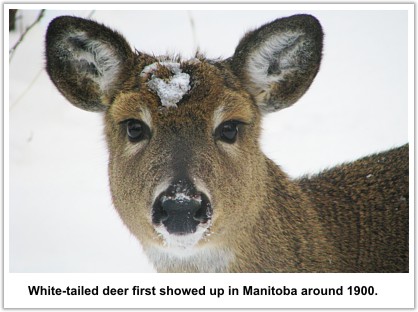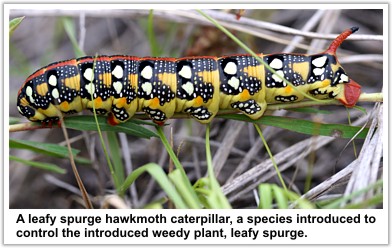![]()
Exotic Animals in Manitoba
By Dr. Robert E. Wrigley, Curator, Assiniboine Park Zoo, Winnipeg
Exotic animals are species inhabiting Manitoba that arrived through
the activities of humans, although the line blurs in cases where humans
have altered the landscape to the degree that has permitted the apparently
recent entry and establishment of dispersing non-native wildlife (e.g.,
White-tailed Deer) following the advent of agriculture. With the great
natural dispersal abilities and adaptiveness of small life forms, countless
organisms have invaded the province since the historical period, from
viruses like West Nile to injurious insects such as the Elm Bark Beetle,
which carries the virulent fungus causing Dutch Elm Disease.
Exotics have also been used widely for agricultural purposes such as all crops, and pollinators (e.g., the alfalfa-pollinating Leafcutter Bee, Megachile rotundata), in pest control (ladybird beetles to devour aphids), and to attack invasive exotic plants (flea beetles to eat Leafy Spurge and Purple Loosestrife). And of course, livestock species (horses, cattle, pigs, goats, sheep, llamas, alpacas, chickens, turkeys, etc) are all exotics, often displacing native wildlife over immense regions. These domestic animals also broadcast weed seeds in their droppings and carry their share of non-native diseases, which all-too-often are transmitted to native wildlife (e.g., Anthrax and Bovine Tuberculosis). The threat of reverse infection, such a Tuberculosis-infected Elk infecting cattle raised in the same area has devastating consequences for both wild populations and the ranching industry, leading to calls for the culling and even eradication of the wild animals, even in conservation areas like Riding Mountain National Park.
No one has any idea how many non-native species of invertebrates (lower animals without a backbone) have been accidentally introduced and become part of the local fauna of Manitoba, but they no doubt number in the thousands. For example, the introduced Pharaoh Ant (Monomorium pharaonis) lives only inside heated buildings, thereby avoiding the cold of winter. Earthworms (There are no native species), slugs, and other invertebrates are particularly common in disturbed areas (e.g., city yards). The Cabbage White Butterfly (Pieris rapae) was accidently introduced from Europe to Quebec about 1860, and has become the most-common butterfly in Manitoba, found in gardens, crops, and forest clearings as far north as Churchill.
There are 12 exotic species of fish in Manitoba, introduced purposefully for sport fishing, or accidentally – Common Carp, Goldfish, Rainbow Smelt, Cutthroat Trout, Rainbow Trout, Koakanee Salmon, Brown Trout, Splake (Lake X Brook trout hybrid), Tiger Trout (Brook X Brown trout hybrid), White Bass, Smallmouth Bass, and Largemouth Bass. Quite likely others will be added to this list in the future through accidents, illegal release, or connecting of drainage systems (i.e., the Missouri system into the Red River in North Dakota).
 Over
100 species of birds have been released into North America, but fortunately
most of these failed to become established. A few, like the Cattle Egret
from Africa and Eurasia, has spread throughout the New World on its
own (with cattle ranching supporting the birds once here), and occurs
sparingly in Manitoba during the summer. Others were released by conservation
departments and game associations for hunting opportunities, such as
Grey Partridge, Ring-necked Pheasant and Wild Turkey – the latter
two usually requiring supplemental food to survive a number of Manitoba
winters. The release of the House Sparrow, Starling, and Rock Dove (Pigeon)
in the United States in the late 1800s has caused unimaginable damage
to ecosystems throughout North America. These birds devour huge amounts
of natural and human foods, confiscate nesting sites formerly utilized
by native species, and foul food supplies and human structures with
their droppings.
Over
100 species of birds have been released into North America, but fortunately
most of these failed to become established. A few, like the Cattle Egret
from Africa and Eurasia, has spread throughout the New World on its
own (with cattle ranching supporting the birds once here), and occurs
sparingly in Manitoba during the summer. Others were released by conservation
departments and game associations for hunting opportunities, such as
Grey Partridge, Ring-necked Pheasant and Wild Turkey – the latter
two usually requiring supplemental food to survive a number of Manitoba
winters. The release of the House Sparrow, Starling, and Rock Dove (Pigeon)
in the United States in the late 1800s has caused unimaginable damage
to ecosystems throughout North America. These birds devour huge amounts
of natural and human foods, confiscate nesting sites formerly utilized
by native species, and foul food supplies and human structures with
their droppings.
Among the mammals, the House Mouse and Norway (Brown) Rat are the supreme invaders, having colonized the entire world (except Antarctica) wherever humans have travelled. These two pests spread out in summer throughout Manitoba into natural habitats, agricultural fields, and in urban alleys, but must retreat to human shelter for the winter period. Both these Old World residents invaded Manitoba first at Churchill via ships of the early explorers, whalers and traders, and their descendants still survive there in buildings and on upper beaches in summer to this day -- well over three centuries later (forts were established by 1670).
Prehistoric humans first arrived into southwestern Manitoba about 8,000 years ago, soon after dry land was exposed from the melting Laurentide Glacier and floodwaters of Glacial Lake Agassiz. Immigrating about 15,000 years ago from eastern Asia, these hunter-gatherers (with ever-advancing cultures and technologies) may also be viewed as a foreign element, in that they invaded an unoccupied continent. However, our species arrived here through natural dispersal (as did thousands of other wildlife species) over a temporary land bridge (Beringia), and hence this case does not fit the definition of exotic. The appearance of humans had major repercussions in many North American ecosystems, mainly through hunting activities (with weapons and use of fire). Humans contributed to the sudden extinction (from 12,000-8,000 years) of over one-half the continent’s large species of mammals and birds.
 Releasing
any foreign species of plant, animal, or other biota into the wild is
biologically indefensible and generally results in unforeseen negative
consequences. While some introduced species have failed to become established,
the successful invaders invariably out-compete similar native species,
outright devour them, or introduce foreign-disease organisms. At the
very least, they occupy habitat of native species, seldom providing
significant food, cover, or other resources for native wildlife. It
is naive and uniformed, whether instigated by a conservation department
or a private person releasing an unwanted pet, to think that such a
release will be a positive step for the organism, the species, or the
biotic community, and yet the practice continues. The problem may sometimes
be compounded by introducing an exotic natural predator of an exotic
pest, as is the current practice in biological control. While occasionally
this proves helpful in reducing (not eliminating) the primary pest,
the fact remains that an additional exotic has been introduced, often
without full knowledge of long-term effects on the ecosystem.
Releasing
any foreign species of plant, animal, or other biota into the wild is
biologically indefensible and generally results in unforeseen negative
consequences. While some introduced species have failed to become established,
the successful invaders invariably out-compete similar native species,
outright devour them, or introduce foreign-disease organisms. At the
very least, they occupy habitat of native species, seldom providing
significant food, cover, or other resources for native wildlife. It
is naive and uniformed, whether instigated by a conservation department
or a private person releasing an unwanted pet, to think that such a
release will be a positive step for the organism, the species, or the
biotic community, and yet the practice continues. The problem may sometimes
be compounded by introducing an exotic natural predator of an exotic
pest, as is the current practice in biological control. While occasionally
this proves helpful in reducing (not eliminating) the primary pest,
the fact remains that an additional exotic has been introduced, often
without full knowledge of long-term effects on the ecosystem.
The release or escape of genetically modified varieties of crops and other organisms are exotics of major concern, since the results frequently have far-reaching effects, including the real possibility of altering the genetics, ecology, or even the survival of wild species. While no doubt a boon to food production and company profitability, transgenic (recombinant-DNA) technology carries inherent risks for species, ecosystems and human health. This is a contoversial issue, with many known and unknown factors to consider. Most countries, including Canada, have embraced this technology (or will in time), since economics and food production are always viewed a higher priority than ecosystem health and wildlife conservation. With increasing and rapid international shipping of goods and travel of people, thousands of additional exotics (from viruses and bacteria to vertebrates) will be introduced to North America and Manitoba in the future. One can only guess what the impacts of all these changes will be on our native biotic communities and on human health.
Editor's Comment
Look what the "introduction" of European humans did to the landscapes of Manitoba! Humans are the ultimate invasive species. We've even figured out how to get off our own planet! How long will it be before we start infesting other worlds? Hopefully, when we do, we'll treat them a little better than Mother Earth.
-- Doug Collicutt, NatureNorth.com --
Photo Credits
Deer image by Doug Collicutt, Angler by Dave Johnson, Caterpillar by Neil Gushulak.
| Return to: IBD Page | NatureNorth.com | Spring | Summer | Fall | Winter |
